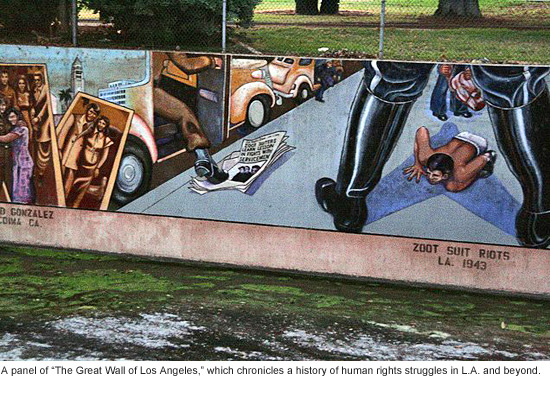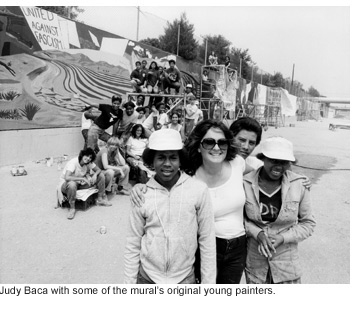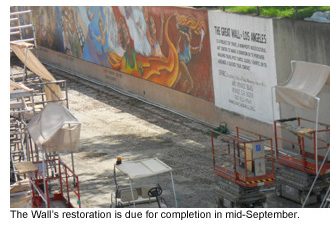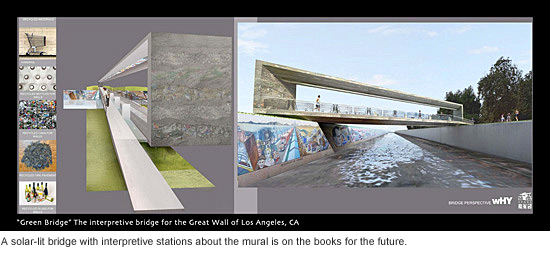A “Great Wall” becomes even greater
August 30, 2011
 Every city has its hidden treasures. Take “The Great Wall of Los Angeles”.
Every city has its hidden treasures. Take “The Great Wall of Los Angeles”.
More than three decades old and 13 feet high, it unfurls like a vibrant tattoo for nearly a half-mile, recounting the history of human struggle and achievement along a concrete retaining wall in the Tujunga Flood Control Channel.
Flanked by a narrow park, it’s easy to miss what’s believed to be the longest mural on the planet. And yet it is this singular work—painted by hundreds of hands in the course of five summers—that launched Los Angeles’ reputation as the world’s mural capital.
Despite such rich origins, few public artworks have had to endure so many indignities. It’s been soiled by car exhaust, corroded by smog, bleached by fertilizer runoff and baked by the relentless sun of the San Fernando Valley. What’s more, political crosscurrents over the decades have generally put the kibosh on obvious possibilities for expanding the project, even as its once radical-seeming material—from the sins of the Spanish missionaries to the Japanese internment—has crossed into the historical mainstream.
“One would think it would have completely disappeared by now, given all it’s gone through,” marvels Judy Baca, the Watts-born activist, artist and UCLA professor whose vision has, since 1976, been the guiding light behind the project. “But what’s remarkable is how much of it is still there.”
Los Angeles has more than 3,000 murals, and their upkeep has been an ongoing civic battle. But next month will bring good news from “The Great Wall.”
 For the past three years, Baca and a crew of artists, volunteers and interns have been painstakingly restoring the artwork. In mid-September, the project is expected to be finished. A ribbon-cutting and celebration are being planned for September 17 at the park near the wall, which lies between Burbank Boulevard and Oxnard Street off Coldwater Canyon Avenue. (Click here for driving directions.)
For the past three years, Baca and a crew of artists, volunteers and interns have been painstakingly restoring the artwork. In mid-September, the project is expected to be finished. A ribbon-cutting and celebration are being planned for September 17 at the park near the wall, which lies between Burbank Boulevard and Oxnard Street off Coldwater Canyon Avenue. (Click here for driving directions.)
After that, Baca says, signage, lighting and a solar-lit “green” bridge with interpretive stations will be added, the better to see and understand the monument to L.A.’s multi-cultural history.
The entire $2.1 million improvement—spearheaded by the Venice-based Social and Public Art Resource Center (SPARC), with funding and assistance from the City of Los Angeles, L.A. County, the California Cultural and Historical Endowment, the Rockefeller and Ford foundations, the Santa Monica Mountains Conservancy, Supervisor Zev Yaroslavsky’s office, and others—should be finished late next year.
That, in turn, will set the stage for a fundraising drive to finish the next four decades of the mural (it now stops in the 1950s) using already-designed sketches that will take the narrative through the Vietnam War and the Los Angeles riots up to the 21st century.
For Baca, now an iconic figure on the Los Angeles art scene, the restoration is both a personal and civic milestone. A one-time high school art teacher in the San Fernando Valley, she has spent the better part of her life as a fiery advocate for public art.
As a summer art teacher in 1970 for the City of Los Angeles, she organized rival gang members in East Los Angeles to paint “Mi Abuelita,” a mural of a grandmother with outstretched arms that for many years was a Hollenbeck Park landmark. The project landed Baca a job as the head of a citywide mural program manned by at-risk teenagers, and led from there to the creation of SPARC, the nonprofit community arts organization.
“The Great Wall,” commissioned by the U.S. Army Corps of Engineers at the behest of the L.A. County Flood Control District to help improve the area around the Tujunga Wash, was SPARC’s first project. Since then, SPARC, for which Baca is artistic director, has produced hundreds of murals throughout the city, commissioning hundreds of artists and training thousands of youth apprentices.
More than 400 at-risk youths, along with scores of artists and historians and hundreds of community members, worked on “The Great Wall” between 1976 and 1984, when painting stopped due to rising costs and safety concerns and the changing political climate during the Reagan Era. Many of those who worked on it found the experience to be life-altering, as this video recounts.
Although the mural’s initial segments were designed by at least 10 artists, each taking a different historical period, it was Baca who created the overall aesthetic beginning with the 1920s mural panel. When the “Great Wall” was started, she was 30. By the time she and her crews celebrate its restoration, she’ll be a week shy of 65. Time, she laughs, has taken a toll on the artist as well as the art.
“We have a funny thing going on down there,” she says of the restoration. “We have the senior citizens, who aren’t body-agile but have great hands, and then we have the younger ones, whose hands aren’t as adept but who have the bodies to continue. We’re transferring knowledge and teaching them to collaborate—it’s a very important moment.”
But, she adds: “I think this will be my last year on the channel. It’s incredibly physically demanding. I think it’s time for the younger people to take over.”
Meanwhile, she says, she’s had the privilege of revisiting a formative period in her life.
“I’m having these dialogues with my younger self on a daily basis,” she says. Simple decisions—what color to use in restoring the image of an Okie, or whether to underscore the Madonna-and-child subtext of a migrant worker holding a baby—“give me this visual of who I was when I painted it,” Baca says.
“That Judy was working with this incredible passion. She had boundless energy and this incredible willingness to put it all out there. This Judy, at 65, would probably say, ‘This is way too hard.’”
If she had to do it all over again, she says wouldn’t change a thing.
Although the project, in retrospect, was an “incredible marathon” and a massive undertaking, she says, it also was “a great labor of love”—and of youthful idealism.
“I may have much more wisdom now, but that girl was limitless,” says Baca. “She was limitless.”















 405 bridge work causes a stink
405 bridge work causes a stink